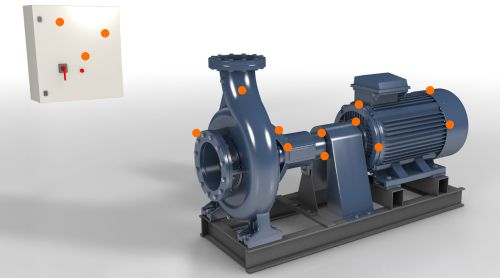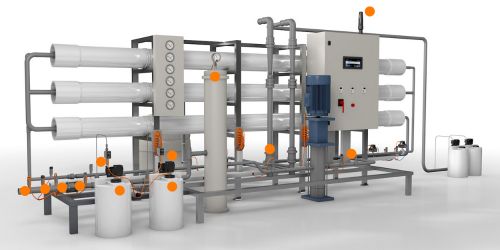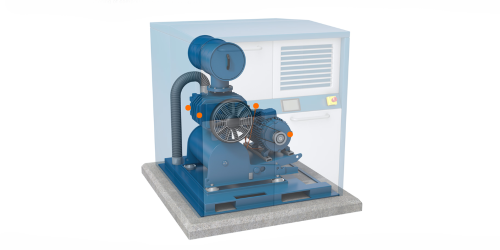International Polar Foundation – Advanced water treatment and filtration

Princess Elisabeth Antarctica research station © 2024 the International Polar Foundation
Innovative water management at the “Princess Elisabeth Antarctica” research station
The International Polar Foundation (IPF) uses ifm solutions to achieve the goal of zero emissions in Antarctica.
Zero-emission buildings will be mandatory in Europe from 2028, as determined by the EU. What is still more or less up in the air in our part of the world has long been a reality in Antarctica. There, Princess Elisabeth Antarctica, the first zero-emission research station, defies the harsh conditions. The iconic, avant-garde building is home to probably the southernmost application of ifm automation technology.
It is a continent of extremes. Ice up to 5,000 metres thick, an average annual temperature of -55 °C, almost 6 months of darkness: Antarctica is probably the most inhospitable place for people to settle permanently – and yet researchers regularly travel to the South Pole to work in a wide variety of research areas such as glaciology, climate research, microbiology and geology, all to gain a better understanding of the world.
To facilitate polar research while protecting the environment, the International Polar Foundation (IPF), in collaboration with the Belgian government and numerous private partners, has founded the “Princess Elisabeth Antarctica” research station. The station, which opened in 2009, is unique in that it is the first and so far only research base in Antarctica that operates emission-free. The station is inhabited for four months of the year and during the eight winter months, it continues to operate autonomously, collecting research data and sending it to Belgium via satellite.
Zero emissions even for water consumption
The electricity required to operate the plant is generated by wind and solar power. Snow and ice provide the researchers and technicians with water. And it is precisely here, in water production and treatment, that there is a great responsibility: “To meet the zero-emission mandate in water management, restoring the purity of the water extracted from snow after it is used and before it is returned to nature is crucial. This is the only way we can truly close the water cycle and minimise our impact on Antarctic nature,” says Aymar de Lichtervelde, the engineer responsible for the project.
From 16 to 50 people
To continue this into the future, a new water treatment plant was put into operation in the Antarctic summer of 2023/24. “The polar station built in 2009 was designed for 16 people. Today, between 40 and 50 people work here during the summer months. Therefore, the water treatment plant had to be expanded to continue to meet demand – and to be able to process the higher volume of industrial water.”

Nicolas Herinckx (left) and Aymar de Lichtervelde (right), engineers at the Princess Elisabeth Antarctica research station, in front of the new water treatment plant: reliable high performance in the smallest of spaces. © 2024 the International Polar Foundation
Higher recycling rate, lower energy consumption
Aymar de Lichtervelde explains what this means in figures: “We estimate a daily water requirement of around 50 litres per person. This is three times less than the average household consumption in Europe. It is important to mention this because, as with energy, the first step is always to reduce consumption. The next step concerns water extraction: we generate 60 percent of our water from nature by melting snow, enriching it with minerals and processing it into drinking water. 40 percent is reused from treated wastewater.” This high proportion of reused water all comes down to the new treatment plant – previously only 20 percent of the water could be reused. The increase has a positive effect on the station’s energy requirements, as recycling the water requires ten times less energy than melting snow.
From 55 litres of industrial water, 30 grams of dry sludge remain
“We can now treat 100 percent of the grey and black water generated in the plant, either to feed it back into our internal cycle or to return it to nature as purified water. As Antarctica is not a country, there are no established standards for the quality of water we are allowed to discharge. The Madrid Protocol sets out several best practices to be followed but does not provide quantitative standards. Therefore, we follow the recommendations for drinking water set out by the World Health Organisation. This basis is ambitious from an ecological point of view and also beneficial for our operations, as we can then reuse the water without it being an issue for users.” A few other figures are impressive, too: the treatment plant can treat 54 out of 55 litres of grey and black water, turning it into ultrapure water; only 30 grams of dry sludge remain per day, the rest evaporates; the sludge is collected and after a few years exported to South Africa to be incinerated.
The added value of IO-Link soon became apparent
“All of this can only be achieved on a sustainable scale if the system functions properly,” says Aymar de Lichtervelde. “For this reason, when we started planning the new water treatment plant two years ago, we decided to use technology that was robust, easy to maintain and easy to replace in an emergency. When we took a closer look at IO-Link, we soon realised that we wanted to use this technology to integrate the sensors into the plant, as it offered us added value in so many ways.”IO-Link is a digital point-to-point communication system in which sensors transmit their data to a master, which then forwards it to the fieldbus level. Instead of laying cables from each sensor into the control cabinet as for conventional analogue wiring, the sensor signals can be collected decentrally by field-compatible IO-Link masters then bundled and transmitted to the next highest field level.
Simple parameter setting, easy installation on site
“ifm’s field-compatible IO-Link masters considerably reduced the wiring complexity,” says Aymar de Lichtervelde. Another advantage of the technology is that the parameters of the individual sensors can be saved on the respective master. When replacing a defective sensor with an identical model, the parameters are automatically transferred to the new device. “This is extremely valuable to us, as the replacement on site can then be carried out quickly and easily. And even by non-technicians.”
The Princess Elisabeth Antarctica is only available to researchers for four months of the year. This precious time makes it all the more crucial for systems to run reliably. “Therefore, we built the complete new plant in Belgium beforehand and tested it intensively. Everything was then disassembled into smaller components for shipping. Here too, the IO-Link principle served us well, as the standardised M12 connectors meant that the rewiring on site was carried out without errors and in a short time.”


Image 1: The IO-Link masters collect the data from the sensors decentrally and forward it to the controller and IT level. The masters are connected via daisy chain, which further reduces the wiring complexity.
Image 2: Overview of current flow, temperature and total quantity: the SM flow meter measures the relevant variables in the smallest of spaces.
© 2024 the International Polar Foundation
SM flow meter: made for confined spaces
The new plant, consisting of two redundant systems, has been fitted with SM flow meters from the automation specialist ifm. In addition to the current flow rate, these also detect the total flow rate and the temperature of the medium. All values are clearly shown on the display. If desired, a red/green colour change indicates whether the values are inside or outside the target range. The optimised measuring pipe ensures a lower pressure loss so that the pump output can be reduced. Neither an inlet nor an outlet pipe is required. This is a huge advantage, especially in confined spaces. Other sensors, including valve sensors and level sensors, provide further important information on the current status of water treatment.
Condition monitoring of the plant also via remote access
Information relevant to the controller and for continuous condition monitoring i.e. all measured values are also transmitted to the IT level – along with additional diagnostic data that provides information about the current status of each individual IO-Link sensor. “This not only simplifies maintenance when at the station, but also allows us to remotely monitor plant conditions during the Antarctic winter months – and prepare it for use during the next research season.”

Aymar de Lichtervelde examines two water samples: on the left is the wastewater discharged at the system’s entry (here black water), on the right is the purified water that can be reused or returned to the environment. © 2024 the International Polar Foundation

The water treatment plant at the Princess Elisabeth Antarctica research station: removal and return to nature are balanced. © 2024 the International Polar Foundation


